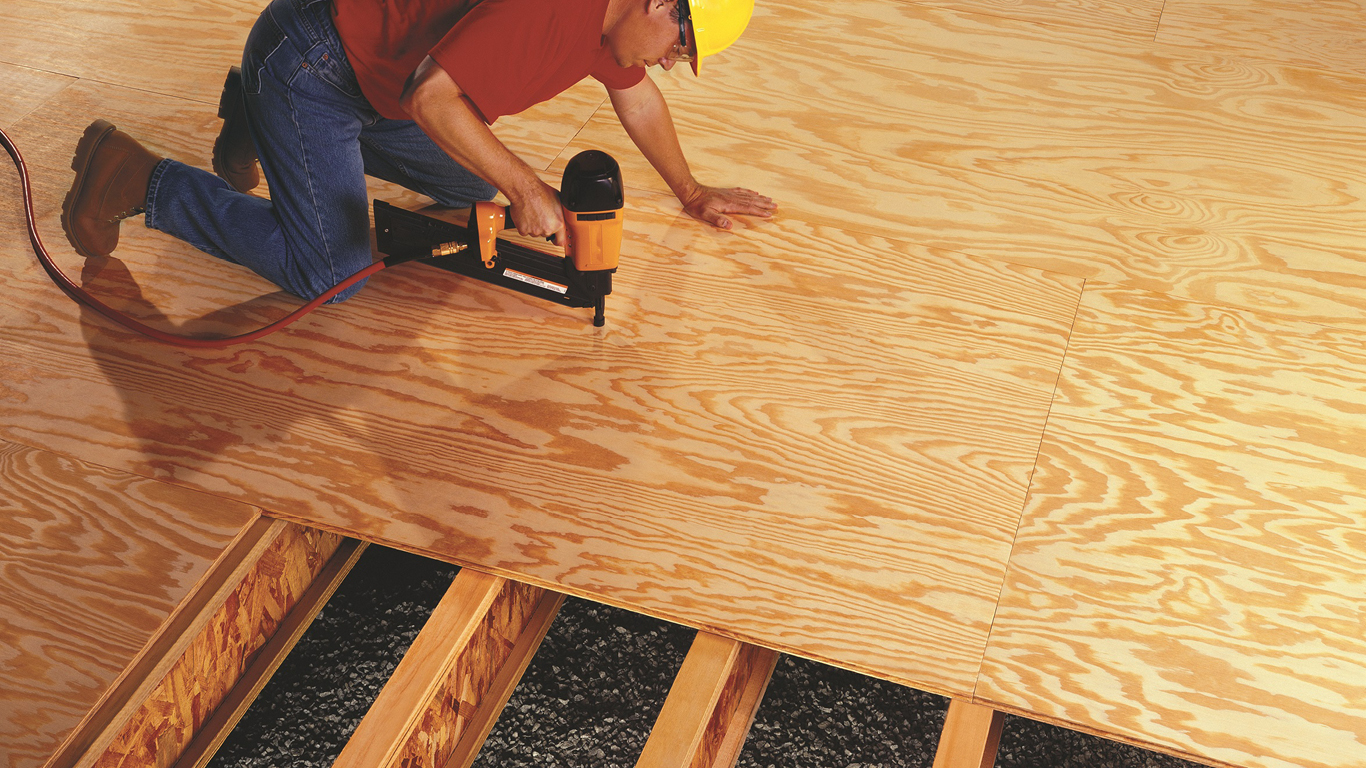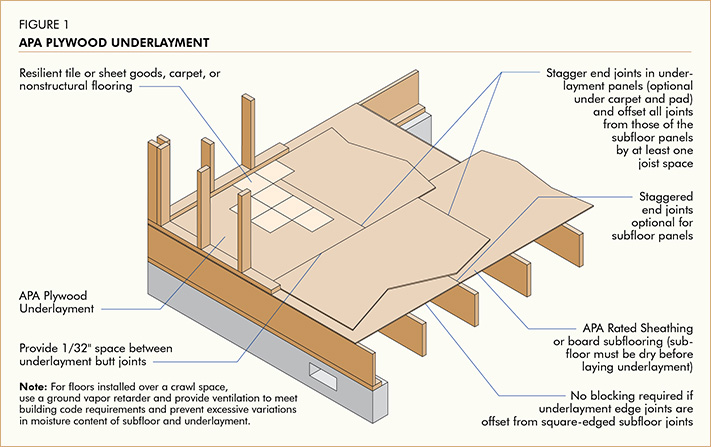Can sheathing plywood be used for subfloor? If you’re embarking on a home improvement project or considering upgrading your flooring, you might find yourself pondering this question. Well, wonder no more! In this article, we’ll delve into the world of sheathing plywood and its potential as a subflooring material. So, let’s dive in and find out if sheathing plywood has what it takes to support your floors!
When it comes to subfloors, there are different types of plywood to choose from, and sheathing plywood is one of them. You may have come across this term before but aren’t quite sure what it means. Fear not, young DIY enthusiast! Sheathing plywood is a type of plywood primarily used for exterior walls or roofs in construction projects. However, its versatility has led some to wonder if it can also be used for subfloors.
But before we jump to any conclusions, let’s take a closer look at sheathing plywood and its qualities. So, grab your toolkit and join us on this informative journey to discover whether sheathing plywood is suitable for use as a subfloor material. Ready? Let’s get started!
Sheathing plywood can be used for subflooring, and here’s why:
- Strength: Sheathing plywood is designed to provide structural support and can handle the weight of flooring materials.
- Cost-effective: Compared to other types of plywood, sheathing plywood is affordable, making it a popular choice for subfloors.
- Availability: Sheathing plywood is widely available, making it easy to find and purchase.
- Durability: With proper installation and maintenance, sheathing plywood can last for many years as a reliable subflooring material.
- Easy to work with: Sheathing plywood is typically easy to cut and install, making it a convenient option for DIY projects.

Can Sheathing Plywood be Used for Subfloor?
When it comes to choosing the right material for your subfloor, there are a variety of options available. One such option is sheathing plywood, which is commonly used for exterior wall and roof construction. But can sheathing plywood be used for subflooring purposes? In this article, we will explore the properties of sheathing plywood, its suitability for subfloor applications, and alternative options for subflooring.
Understanding Sheathing Plywood
Sheathing plywood, also known as structural plywood, is a type of plywood that is manufactured specifically for use in construction projects. It is made by gluing together multiple layers of thin wood veneers, with each layer being oriented at a right angle to the adjacent layers. This structural arrangement gives sheathing plywood its strength and stability.
Sheathing plywood is typically made from softwood species such as Douglas fir, pine, or spruce. It comes in various thicknesses, ranging from 1/4 inch to 3/4 inch, and is commonly available in 4×8 feet sheets. The quality and durability of sheathing plywood can vary depending on the manufacturer and grade.
Although sheathing plywood is primarily designed for use as exterior wall and roof sheathing, it may also be considered for other applications such as subflooring. However, there are several factors to consider before using sheathing plywood for this purpose.
The Strength and Durability of Sheathing Plywood for Subflooring
One of the main concerns when using sheathing plywood as a subfloor material is its strength and durability. While sheathing plywood is structurally sound and can handle typical loads associated with subflooring, it may not be as strong or durable as other subflooring materials specifically designed for this purpose.
Sheathing plywood may be suitable for low-traffic areas or temporary flooring, such as in construction sites or event spaces. However, for long-term usage or areas prone to moisture exposure, it is recommended to use subfloor-grade plywood or other subflooring materials that are specifically treated to resist moisture and provide better structural support.
Moisture Resistance of Sheathing Plywood
One of the drawbacks of using sheathing plywood for subflooring is its limited moisture resistance. Sheathing plywood is not designed to withstand prolonged exposure to moisture, and if it gets wet, it may warp, delaminate, or degrade over time.
In areas where moisture is a concern, such as bathrooms, kitchens, or basements, it is crucial to use subfloor materials that have better moisture resistance, such as moisture-resistant plywood or oriented strand board (OSB) with a waterproof coating. These materials are specifically designed to withstand moisture and prevent issues such as mold, rot, and structural damage.
It is worth noting that even if sheathing plywood is used as subflooring, it should always be protected by a suitable moisture barrier, such as a waterproof membrane or underlayment, to prevent moisture from seeping through and causing damage.
Alternative Subflooring Options
If sheathing plywood is not the ideal choice for your subflooring needs, there are several alternative materials that can provide better performance and durability:
- Subfloor-grade Plywood: This type of plywood is specifically manufactured for subfloor applications and is designed to provide superior strength and moisture resistance.
- Oriented Strand Board (OSB): OSB is an engineered wood product that consists of layers of wood strands bonded together with resin. It offers excellent strength and moisture resistance and is often used as a cost-effective alternative to plywood for subflooring.
- Cement Board: Cement board is a durable and moisture-resistant material commonly used in bathrooms, kitchens, and other areas with high moisture levels. It is often used as an underlayment for tile or stone floor coverings.
- Drywall: In some cases, such as temporary or non-load-bearing floors, drywall can be used as a subflooring material. However, it is not as strong or durable as other options and should only be considered for specific applications.
Before making a decision on which subfloor material to use, it is essential to assess the specific requirements of your project, including the anticipated load, moisture conditions, and budget constraints. Consulting with a professional contractor or architect can help ensure you choose the most suitable material for your subflooring needs.
The Pros and Cons of Sheathing Plywood for Subflooring
While sheathing plywood may be considered for subflooring in certain situations, it is important to weigh the pros and cons before making a decision:
Pros:
- Cost-effective compared to some subflooring materials.
- Readily available at most home improvement stores.
- Relatively easy to install.
- Can provide sufficient structural support in low-traffic areas or temporary flooring.
Cons:
- Limited moisture resistance compared to subfloor-grade plywood or other moisture-resistant materials.
- May not provide the same level of strength and durability as materials specifically designed for subflooring.
- May require additional moisture barriers or coatings to prevent moisture-related issues.
- Not recommended for high-traffic areas or long-term flooring solutions.
Conclusion
While sheathing plywood can be used for subflooring in certain situations, it is important to consider its limitations in terms of strength and moisture resistance. For areas prone to moisture exposure or high-traffic areas, it is advisable to choose subfloor-grade plywood, oriented strand board (OSB), or other moisture-resistant materials that are specifically designed for subflooring. Consulting with a professional contractor or architect can help ensure you select the most suitable material for your subflooring needs. Remember to always prioritize structural integrity and moisture resistance to ensure a durable and long-lasting subfloor.
Can Sheathing Plywood be Used for Subfloor?
When it comes to using sheathing plywood for subfloor, here are the key takeaways:
- Sheathing plywood can be used for subfloor if it meets certain criteria.
- Sheathing plywood should have a thickness of at least 5/8 inch for subfloor use.
- It is important to select a sheathing plywood with a proper grade for subflooring.
- Sheathing plywood should be installed properly to ensure stability and strength.
- It is recommended to consult with a professional or refer to building codes for specific requirements.
Frequently Asked Questions
When it comes to subfloors, there are various materials to choose from. Can sheathing plywood be used as one of them? Let’s find out!
Is sheathing plywood suitable for subflooring?
Yes, sheathing plywood can be used as a subflooring material. Sheathing plywood is typically made from multiple thin layers of wood veneers glued together, creating a strong and durable panel. Its structural integrity makes it a popular choice for various construction projects, including subflooring.
However, there are a few considerations to keep in mind. Sheathing plywood is generally used as an underlayment or a base for other flooring materials, such as hardwood or carpet. It provides a solid surface for these materials to be installed on top of. If you’re planning to have a sheathing plywood subfloor, you may need additional layers, such as flooring-grade plywood or cement backer board, to achieve the desired finished flooring result.
What are the advantages of using sheathing plywood for subflooring?
Using sheathing plywood for subflooring offers several advantages. Firstly, sheathing plywood is relatively affordable compared to other subflooring materials, such as oriented strand board (OSB) or specialty subfloor panels. This can be a cost-effective choice for those on a budget.
Secondly, sheathing plywood is easy to work with and install. It comes in standard sizes and can be cut to fit the dimensions of your subfloor. Additionally, sheathing plywood is readily available at most home improvement stores, making it convenient to source for your project. Lastly, sheathing plywood offers good dimensional stability, meaning it is less prone to warping or swelling when exposed to moisture, making it a suitable choice for subfloors.
Can sheathing plywood be used for all types of subflooring?
While sheathing plywood can be used for subflooring, it might not be suitable for every situation. Sheathing plywood is typically used for above-grade applications, meaning it is meant for floors that are not in contact with the ground.
If you’re planning to install a subfloor below ground level, such as in a basement, it’s recommended to use materials specifically designed for below-grade applications, such as pressure-treated plywood or concrete. These materials have added protection against moisture and potential issues associated with being below the ground level.
Do I need to add additional layers over sheathing plywood subfloor?
In most cases, it’s advisable to add additional layers over sheathing plywood for optimal results. While sheathing plywood provides a solid base, it may not have the smoothness or the necessary thickness for installing certain types of finished flooring, such as hardwood or tile. Adding a layer of flooring-grade plywood or cement backer board can help achieve a smoother and more suitable surface for these materials.
It’s important to consider the requirements of your specific flooring choice and consult the manufacturer’s recommendations. They will provide guidance on the appropriate subfloor preparation, which may include the need for an additional layer over the sheathing plywood subfloor.
Can sheathing plywood be used as a temporary subfloor?
Yes, sheathing plywood can be used as a temporary subfloor. Temporary subfloors are commonly used during construction or renovation projects to provide a stable surface for work and to protect the finished flooring from damage.
Sheathing plywood is a suitable choice for temporary subflooring due to its strength and affordability. It can withstand the weight and foot traffic during construction and can be easily removed or replaced once the project is complete. However, it’s important to note that temporary subfloors are not designed for long-term use and may not provide the same level of support and durability as permanent subflooring materials.

Summary
So, can sheathing plywood be used for subflooring? The answer is yes, but with caution. Sheathing plywood is a type of plywood that is commonly used for exterior walls, roofs, and floors. It can be used as a subfloor, but it may not be as strong or durable as other types of plywood specifically designed for subflooring. It is important to consider factors like moisture resistance and thickness when using sheathing plywood for subfloors. It’s always recommended to consult a professional or follow manufacturer guidelines to ensure the best results and structural integrity of your subfloor.
